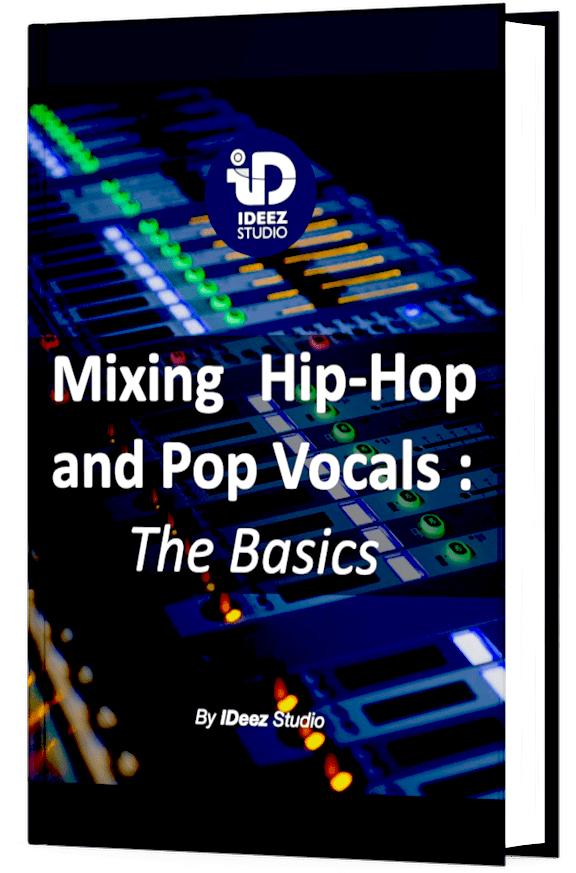More and more studio headphones are available on the market today. And making a choice that fits your needs is essential to make the purchase worthwhile. But how to choose? What criteria should you take into account? I give you the answer in this article.
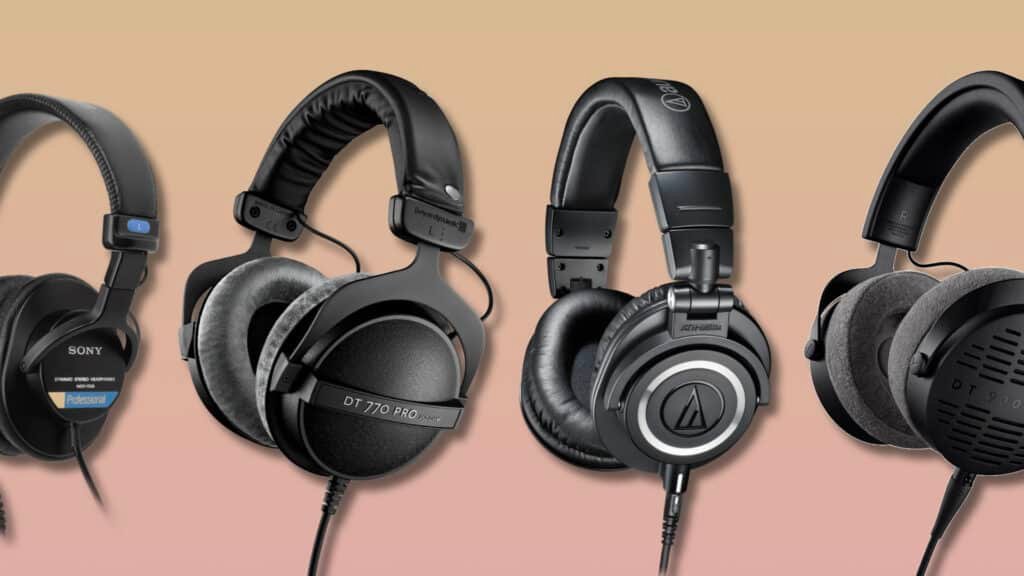
Here are the 8 things to consider for choosing your studio headphones:
- Closed-back vs open-back headphones
- Frequency response
- Type of operation
- Durability
- Noise isolation
- Price
- Comfort
- Impedance

Why is the choice of studio headphones important?
If you’re about to buy new studio headphones, you probably intend, for one reason or another, to use them very often in the months and years to come. And, contrary to what many people think, studio headphones are not a tool that is meant to reproduce the audio source as flat as possible in your ears.
If the goal was simply to choose the one with the flattest frequency response at the most attractive price, the choice would be easy and very quick.
What you should keep in mind before you start the research process is that all studio headphones have something unique to offer over their competitors. And, no, it’s not always the frequency response that’s most important to some manufacturers.
And while frequency response is certainly important when choosing studio headphones, it can’t be the only criterion to consider. Many other factors will also play a role in your decision.
Durability and comfort are, for example, two very important criteria since you will most likely spend many hours with the studio headphones you buy. If you plan to use them for recording sessions, isolation would be a priority.
As you will have understood, there are so many criteria that differentiate all the possibilities of the market that you can quickly choose something that would not correspond at all to your needs. This is what I want to avoid at all costs.
Because choosing the wrong studio headphones can lead to frustration, lack of productivity and considerable loss of time. But if you choose the right ones, following the criteria I’m about to give you, you’ll avoid all that!
Which Retailer should I go to?
If you’re looking for new studio headphones, you might also be wondering which retailer you should go to. If you live in the United States, there are many retailers you can trust. Each one has its pros and cons.
A. Amazon

The most famous worldwide is obviously the great Amazon. In audio, you can find almost everything there, it’s pretty crazy. But let’s insist on the word “almost”, because often, the smallest manufacturers of studio headphones are not found on Amazon. Yet, you might be able to find what you need at these “small” manufacturers. Amazon may therefore “block” you in your search.
Another disadvantage: Amazon is not a dedicated audio retailer. There will be no audio expert service to help you in case of problems or simply for advice.
On the other hand, Amazon is often irreproachable in its delivery and return system. You literally have no chance of having problems in this regard by going through Amazon, and the service will probably be very fast.
B. Sweetwater
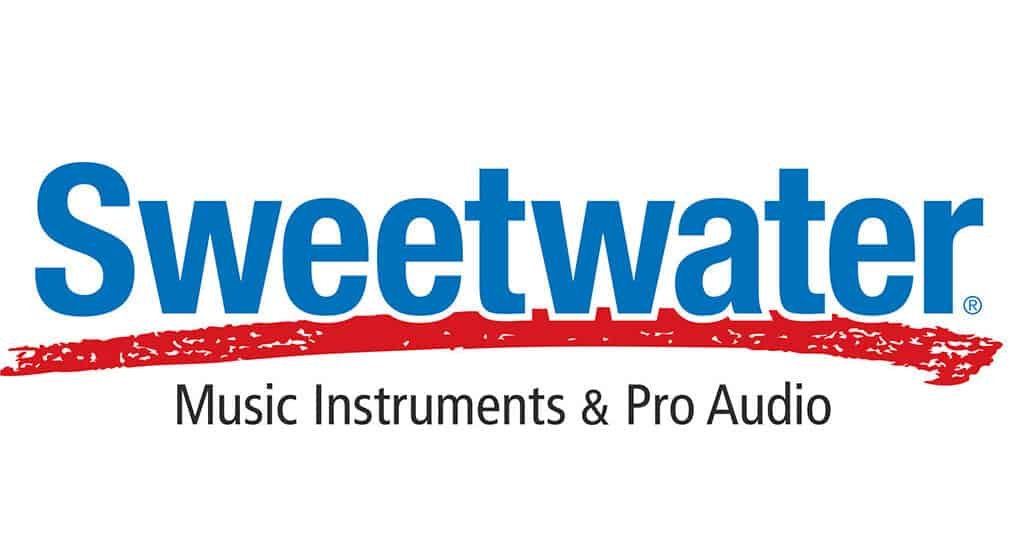
Sweetwater is a Fort Wayne, Indiana based company that has been in business since 1979. With their super wide range of products, they are probably the largest retailer of audio equipment today.
The website interface is quite nice, the service is good, the products are well selected and well organized,… In short, Sweetwater represents a very nice option in the choice of retailer.
If you like buying second hand, you will also have the possibility to go on the sub-domain, called Gear Exchange. It’s a platform where you can buy and sell used products at low prices. A great idea.
C. Guitar Center

Despite its name, which may mislead some, Guitar Center is also one of the largest retailers of audio equipment in the United States and worldwide.
Founded in 1959, the American company has hundreds of retail locations across North America and oversees several subsidiaries such as Musician’s Friend, Music & Bass and AVDG.
Although the services are largely focused on musical instruments (guitars, basses, drums, keyboards,…), there is a good chance that you will find something to suit your needs, given the wide range of products offered by Guitar Center.
The choice of retailer is not crucial in itself, as the product will always be the same and will be delivered in a very similar way with each retailer.
But if you are going to make more audio equipment purchases in the future, it is always more convenient to use a website that you feel comfortable with.
Now it’s time to get to the heart of the matter!
Need a professional sound engineer specializing in pop and hip-hop mixing ? Great! Take a look at our services and let’s blow up your career together!
Let’s start now!
1. Closed-Back vs Open-Back headphones
The first thing to consider when choosing your next headphones is whether you want to go with closed-back or open-back. Depending on your future use, this choice is simply essential.
ℹ️ Not sure what the difference is between closed-back and open-back headphones? Then I suggest you read this article first: Closed-Back vs Open-Back Headphones: What Is The Difference?
As a reminder, the difference between closed-back and open-back headphones is the way they are designed. Indeed, closed-back headphones have a closed external envelope, which allows to isolate the listening from the external environment. Open-back headphones, on the other hand, have an open outer shell, usually in the form of a grille, allowing air and sound waves to pass through.
Between the two types of headphones, there is no better choice. They should be choices that fit your needs.
Go For closed-back headphones if…
- Your goal is to use your headphones for a wide range of purposes (recording, mixing, mastering, production,…). The choice is quickly made. Closed-back headphones are clearly the best choice for their versatility.
- You plan to do a lot of recording sessions. When recording, you can be sure that there is no risk of feedback in the microphones since the sound coming into the headphones will not escape.
- You often work with other people in the same room. If several musicians, producers, technicians, etc,… are working in the same room, each one will have the big advantage of having only his own mix in his ears and no unwanted external noise.
So on a purely practical level, closed-back headphones are better than open-back! But other aspects can give open-back the advantage.
Go for open-back headphones if…
- You work a lot of the time alone, without any other people around you. The sound coming out of your open-back headphones will therefore not be a problem.
- Your favorite areas in music are mixing, mastering and/or production, and very little recording. So you won’t need to isolate your listening from the outside environment.
- You want to focus on accurate, deep, clear and open monitoring. The sound quality of open-back headphones is generally much better than that of closed-back headphones. That’s something to consider as well.
If you don’t really know what to go for, then I advise you to start with closed-back headphones. This choice will be much less risky in term of isolation.
2. Frequency response
Contrary to what many music production enthusiasts think, the frequency response curve can be very different depending on the brand and model of headphones. Just because they are studio headphones does not mean that the frequency response is 100% neutral.
Some studio headphones boost or cut certain frequency ranges quite drastically. But that doesn’t make these headphones bad products. And in the other hand, some fairly neutral headphones are far from being the best.
But, knowing this, how do you make the right choice? What criteria should you take into account so that you are not disappointed with your purchase? You have to take into account 2 main criteria:
A. Your Tastes
It seems quite logical, your tastes must come first. But in reality, it’s not that simple, you have to try to combine your tastes with more technical aspects.
Do you like round and soft basses or punchy ones? Do you prefer to have mid-frequencies in the foreground or relatively balanced? You’ll understand, being able to put the technical aspect in parallel with your tastes is essential to make the right choice.
If you have the opportunity, try to test a maximum of headphones to have more precision on your tastes and thus make better choices.
B. Musical genre
The musical genre in which you work in general is almost as important as your taste. In fact, some headphones will produce impressive results with certain genres.
But let’s stay on the same page, that doesn’t mean that very good headphones will sound bad with certain genres. It’s simply a matter of making clear choices based on the genre.
For example, it will be useless to choose headphones that slightly boost the subwoofer if you work in jazz music. Just as it will not be very smart to choose headphones that reproduce the highs in a very soft way if you are mixing or producing pop music.

Apart from these two aspects, what is most important is what you hear. So once again, the best thing to do is to try a few studio headphones before making your choice.
Don’t hesitate to look at the frequency response curves announced by the manufacturers but also at the users’ reviews. These two elements can sometimes give a lot of information.
Most neutral frequency response
Philips Fidelio X2HR
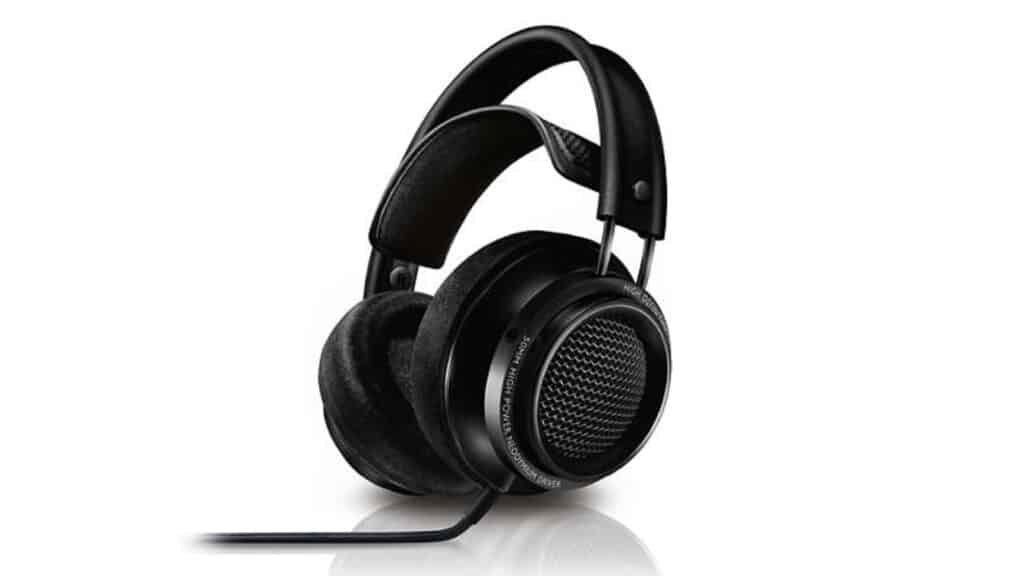
The X2HR open-back headphones are probably the studio headphones with one of the most neutral frequency response curves in their price range. On top of that, they are very comfortable and not very expensive for the quality they deliver.
If you are looking for something reliable in terms of sound quality, I recommend you to take a look at them!
3. Type of operation
Without going into too many technical details, it is important to know that some headphones are specifically made for certain operations: mixing, mastering, recording,… In the field of studio headphones, this is what we call the type of operation.
For many entry-level studio headsets (between $150 and $250), it will not necessarily indicate the type of operation. The reason is simple: these headsets are made to be as versatile as possible and suitable for a maximum of different situations.
But when you go up in the ranges, you will quickly notice that many headphones are made to be used in very specific situations such as mixing, mastering or recording (monitoring).
And although sometimes, some studio headphones “made” for a certain use also correspond to other uses, it is still an indication given by the manufacturer himself. So I advise you to follow this indication to avoid unpleasant surprises.

4. Durability
One thing you should know before you start looking, a high price does not necessarily mean that the device has good durability. This is not always the priority of the manufacturers.
Using studio headphones that lasts a long time will save you from spending a certain amount of money several times rather than spending a little more money once for a better durability.
But what should you look at to know if the durability of studio headphones is good or not? Here are some hints…:
- Reviews: Yes, user reviews are the first indicator to rely on for this kind of criteria. If you do a little research on the studio headphones you’re thinking of buying, you’ll most likely find reviews on this topic.
- Robustness: Robustness is a fairly broad criterion because it encompasses many different sub-criteria. But it’s usually pretty easy to tell if studio headphones are of good build quality or not, especially if you can physically hold them. The elasticity, the materials used, the modulability,… All of this can be taken into account.
- Possibility to buy spare parts: It could happen, after a few months or a few years, that one of the components of your headphones is broken and that it damages all its function. If no spare parts are available, you will have no choice but to buy new studio headphones. But if there are spare parts specially sold, then you can easily replace the defective part and continue to use your headphones without spending huge amounts of money.
Best durability
Beyerdynamic DT 900 Pro x
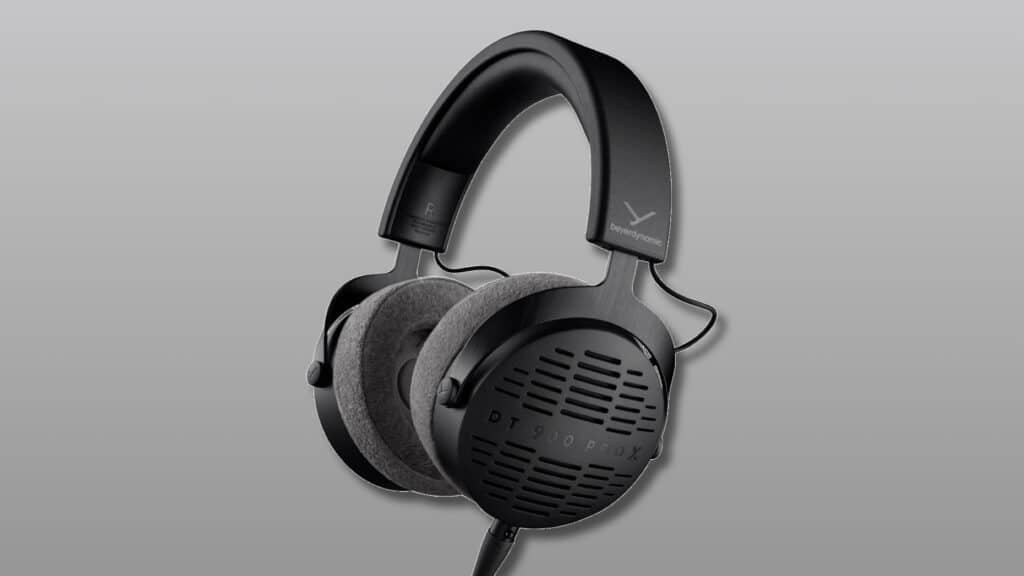
These DT 900 Pro X represent the new generation of headphones from Beyerdynamic. This pair of studio headphones is equipped with all the best audio technologies for a breathtaking sound.
But it is also in term of durability that it is impressive. The materials are of good quality, the assembly is irreproachable, the headphones are robust. In short, everything is perfectly designed to make these studio headphones last through the years.
If you’re looking for comfortable and durable open-back headphones with accurate and detailed sound quality, then these DT 900 Pro X are for you!
Need a professional sound engineer specializing in pop and hip-hop mixing ? Great! Take a look at our services and let’s blow up your career together!
Let’s start now!
5. Noise Isolation
Just because you have studio headphones doesn’t mean that the noise isolation will be ultra-high. Again, chances are that this is not the manufacturer’s priority. Even less so if they are open-back headphones, where the isolation would simply be zero.
Depending on how you use them, good isolation can be a good thing or a very bad thing. If you don’t mind hearing a little bit of noise from the room you’re in, then isolation is of little importance.
But if you like to be in your own bubble to work (or you want your artists to be), then the focus should definitely be on noise isolation.
The problem is that isolation is not always a criterion officially described by the manufacturer. So I have only one piece of advice for you: do some thorough research on the headphones you are thinking of buying. That’s where you’ll usually find more concrete information about the isolation quality.
Generally speaking, leather earpads are better than others in terms of isolation. But if the surrounding materials are light, leather will be less efficient. So get the information you need before you buy!
Best Noise Isolation
Audio-Technica ATH-M50X
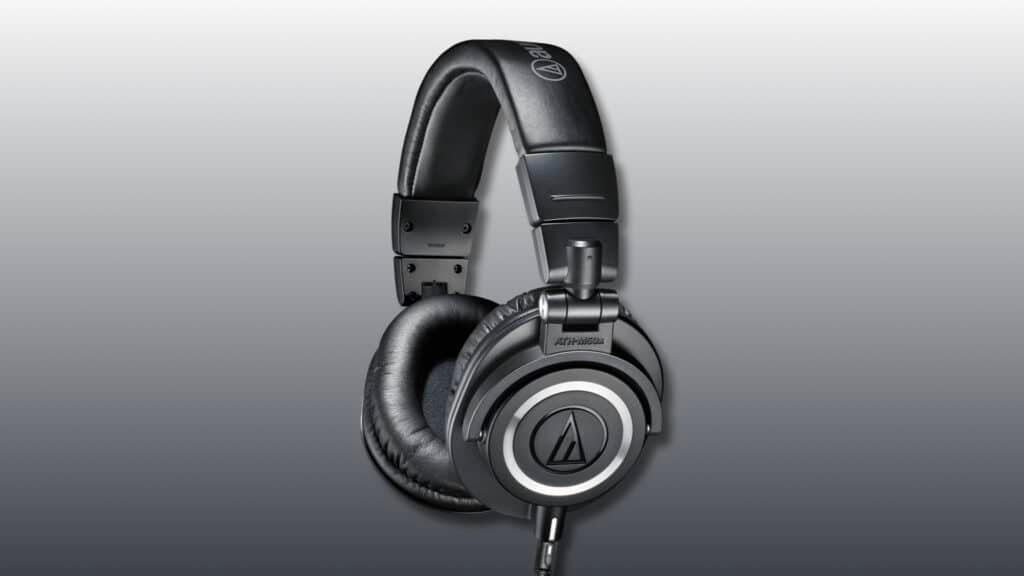
The ATH-M50X are not the most neutral headphones, nor the most durable, but they do have an advantage over other brands: the quality of the noise isolation.
Although they are circumaural headphones (we’ll see what that’s all about below), their isolation is quite impressive and really lets you be in your own bubble.
If you are looking for studio headphones for monitoring, with a well rounded low end and a soft high end, you can clearly go for these ATH-M50X.
6. Price
It seems obvious, the price of the headphones will most likely have an impact on your final choice. It’s pretty logical that you won’t look for $2000 headphones if your budget is $200. But you have to look at it both ways…
- Of course, you shouldn’t fall into the trap of choosing studio headphones that are totally out of your budget just to get that little extra quality. You may not even hear a noticeable difference between super expensive headphones and cheap headphones.
- But you shouldn’t be too price conscious. For example, if you’re deciding between 3 studio headphones and your favorite is $50 more expensive than the other two, go for it!
This is a long-term investment. If you need to spend a few dozen dollars more to get exactly what you want, I really advise you to do so. Otherwise, you might regret it and under-use your studio headphones.
As for the budget, always keep in mind that it should be in accordance with your general level in the field you work in. Don’t look for $500 headphones if you are a beginner. On the other hand, if you are a pro, your status doesn’t necessarily require you to buy expensive studio headphones. I personally have been working with DT-770s, supposedly entry-level, for several years and I’m very happy with them!
Best Price
Sony MDR7506
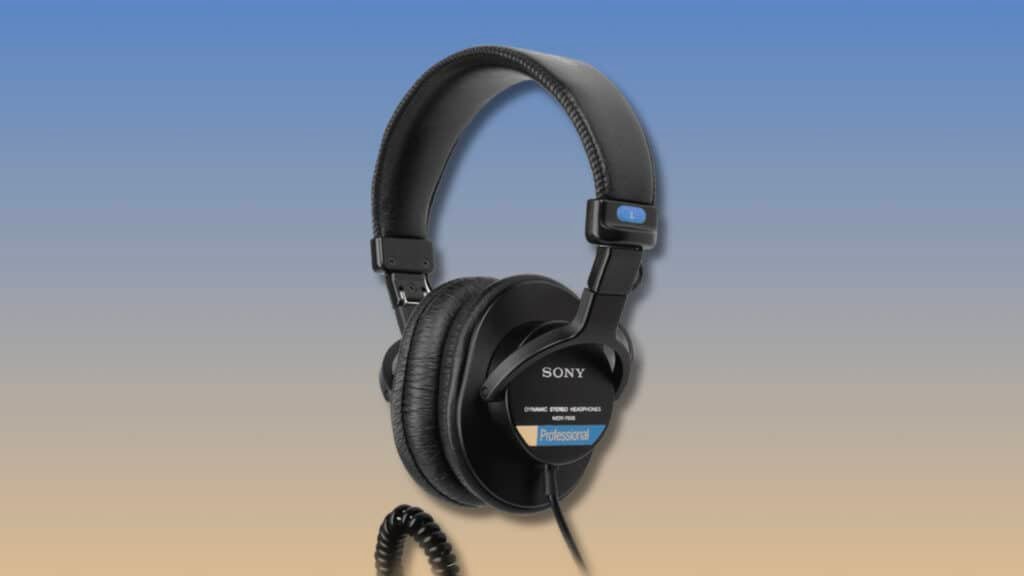
The first time I listened to one of my mixes with these MDR7506, I was just… impressed! The sound is really reliable: the bass is powerful without being excessive, the mid-range has a nice presence in the ears and the highs are brilliant without being aggressive.
These headphones actually have all the ingredients of a very expensive studio headphone. But in reality, they are really cheap and are probably the best value studio headphones on the audio market.
If you want to experience professional sound without spending tons of money, then go for it, these MDR7506 are for you!
7. Comfort
I think I’m right in assuming that you will most likely spend many hours with these new studio headphones on your ears, right? Trust me, a lack of comfort can quickly lead to a lack of productivity. So don’t neglect comfort!
The best thing to do is to try several headphones in a store and judge their comfort from there. But this is the age of online shopping, and I suppose there’s a good chance you won’t be able to try any headphones before buying one.
So here are some criteria you can consider when judging the comfort of studio headphones:
A. Circumaural vs supra-aural
Regarding the shape of the studio headphones earpads, there are 2 types: circumaural and supra-aural. They are differentiated by their size, but also by the way they are placed on the ears.
- Circumaural headphones have the largest earpad circumference. They are placed around the ear, on the skin of the head. They are generally particularly comfortable.
- Supra-aural headphones, on the other hand, are much smaller at the earpads. They will thus be placed on the ear. The isolation is generally more optimized but the risk of pain after several hours of work is increased.
B. Materials
Still on the subject of earpads, the materials they are made of clearly have an influence on comfort.
Generally speaking, leather earpads are less comfortable to wear over several hours because they don’t breathe enough. So you have a big risk of getting damp and sweaty inside after a few minutes of use. To be taken into account too!
C. Headband
The headband also has an influence on the overall comfort of studio headphones. Indeed, a badly designed headband (or one that does not fit the shape of the head) can create pain that can last for several hours.
Generally, headbands that are relatively elastic and made of soft, supple materials contribute to optimal comfort.
Most Comfortable
beyerdynamic DT 770 Pro

You don’t even have to wear these headphones to see that they are super comfortable. With their shape, velvet earpads and leather-wrapped foam headband, the DT 770’s comfort is simply impeccable.
In addition to comfort, these studio headphones are one of the most highly regarded headphones in the world for their overall quality. The sound is well balanced, they are practical for recording sessions, they have impedance variations, they are not expensive, their isolation is quite good,… Everything is there!
By buying these DT-770 you will be using one of the most used studio headphones in the history of music. And that’s no mean feat!
ℹ️ In 2022, the DT 770s are still among the top studio headphones in the world. But why? I’ll tell you all about it here: Why The DT-770 Headphones Are Still The Best In 2022
8. Impedance
The impedance of studio headphones is not really the most important criterion, but it is still important to know before buying.
As a reminder, impedance represents, roughly speaking, the electrical resistance of a device. It is measured in ohms. The higher the impedance, the stronger the resistance to the input signal.
As you can see, the resistance has a great influence on the level of your headphones. Especially if you have a sound card in your studio/home studio, you will never have problems with levels, even with the highest impedances.
But if you plan to use your studio headphones with your computer’s consumer amps (mini-jack connection), you may be limited in terms of listening volume. Because these amps are not designed to deliver very powerful amplification.
If this is the case, and you don’t have enough power to amplify the headphone signal, then I advise you not to go above 80 ohm. If you go above that you risk having a relatively low maximum volume.
Need a professional sound engineer specializing in pop and hip-hop mixing ? Great! Take a look at our services and let’s blow up your career together!
Let’s start now!
Conclusion
Choosing studio headphones is more complicated than just considering sound and comfort. Type of operation, durability, noise isolation, price and impedance are also factors to consider.
Taking all these criteria into account can take time… a lot of time! But it will allow you to choose studio headphones that fit you perfectly, that will allow you to be more productive and therefore save time in the long run.
If you have any questions about studio headphones or about anything in the field of music mixing, please contact me, I’m always very happy to help!
Related Articles:
My favorite tools for mixing pop and hip-hop music:
Plugins
In the field of auto-tune, I’m convinced that nothing’s better and more efficient than Antares Auto-Tune Pro. As for the EQ’s, FabFilter Pro-Q3 and Slate Digital Infinity EQ are, in my opinion, the best tools. For compression, I have 2 favorites plugins: Waves RComp and UAD EL8 Distressor.
As for reverb, I’m a big fan of the Soundtoys Little Plate, but generally, I go for the Valhalla VintageVerb for its versatility. I also love the Arturia Rev PLATE-140 and the UAD Pure Plate for its organic side.
Headphones
The closed headphones I love and will always love using for mixing pop and hip-hop music are the Beyerdynamic DT-770. As for the best open-back headphones, I use the Sennheiser HD600 headphones, and I’m really happy of them!
Monitors
Having a pair of Yamaha HS7 in its studio or home studio is always cool for more excitement while listening to your mixes. The Adam Audio T7V monitors are also super accurate. In my studio, I also have a pair of Genelec 8030 for their reliability.
Hardware gear
For anyone who wants to start using hardware in their mixes, I always recommend these 2 units from Klark Teknik: the EQP-KT and the 76-KT. Don’t forget to use good converters, such as the Apollo interfaces. This is essential for a good rendering.



